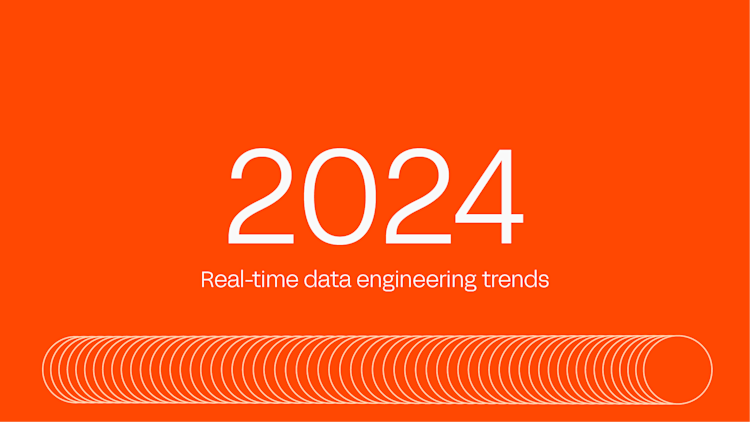Real-time data engineering trends: 2024
In 2024, data architectures and practices will undergo a radical transformation, becoming unrecognizable. Welcome to the Fifth Industrial Revolution.

If 2023 was the year we woke up to how generative AI would change our world, 2024 is the year we realize the change.
The real-time AI-driven enterprise may not be pixel-perfect yet, but we’re well on the way. Gen AI has a knock-on effect on all the trends and challenges we will see in 2024. Here’s our take.
Gen AI is opening up new data sources never previously integrated into data architectures. This includes customer legal contracts or IT service desk tickets.
Architects and engineers are now tasked with making sure this explosion of sources are integrated effectively with self-service availability; balancing scalability, cost-efficiency, legislative compliance, and data reliability.
This is going to be the deciding factor that forces enterprises to rethink their architectures and their data operations practices.
In 2024, the emphasis will not just be on the accuracy of gen AI applications, but also on the timeliness of the data they are trained on. A shift is expected from internal-facing gen AI apps that boost employee productivity, to consumer-facing apps that will significantly disrupt not only organizations – but entire markets.
The best gen AI apps will need to be integrated with streaming feeds and contextual information. Consider an airline chatbot answering a request to change your flight, and making adjustments to your booking accordingly.
Their models – whether predictive or generative – will need to continuously learn from real-time data to fully drive automation and offer the best experience to consumers.

Striving to improve engineering productivity is nothing new. But the rising demand for AI applications will place data and software engineers at the forefront of innovation, and with it comes the pressure to deliver faster.
Making data sharing and exploration easier for developers will move from a nice-to-have to a necessity in 2024. Teams that prioritize developer experience will reduce the time-to-market of data products and reduce reliance on centralized teams.
Application, analytical, and AI workloads will converge further into the same data architecture, but hosted on different clouds. Decentralizing data management and data mesh principles is also fueling the move away from multi-tenant data platforms, to fragmented, single-tenant technology stacks.
But on-premise infrastructure and workloads won’t die. They may even grow as data sovereignty, regulation, risk reduction and managing cloud costs become key considerations.
The concentration of a handful of cloud vendors supporting enterprise infrastructure “is a significant emerging risk,” according to Gartner’s last two quarterly risk reports.
As businesses need to move fast to respond to the market with a pick-and-mix of data technologies, concerns about vendor lock-in are on the rise.
In 2024, engineers will need to address technical barriers to integrating data and technologies across clouds, systems and environments. The ability to route data quickly in response to the evolving gen AI landscape means that if data integration and vendors are as tightly coupled as they were previously, this won’t work.
One example we see is increased demand for Open-Source connectors that integrate with a range of clouds and technologies to enable data sharing, and facilitate critical flows.
With AI’s rapid evolution, regulatory bodies are playing catch-up. Political changes in key countries are already accelerating the introduction of new regulations – from the European Union’s AI Act, to the US executive order on AI – particularly concerning the transparency of model training.
This will mean organizations will need to be transparent about how their AI services are trained, and how they operate. To achieve this, teams should create the guardrails and visibility to avoid the spread of inaccurate information or bias.
Organizations will need to focus on training, tooling, and data governance practices to help engineers understand AI and the decisions they make in building it, for a tsunami of regulation to come.
What engineers need to learn in 2024 will be different, and so will the way they learn.
Suppose that by the end of the year you are no longer an engineer, but a product owner. It’s your first day in a new role, and for your onboarding you open a personalized workplace assistant that provides you with key context about the work you need to do today.
Prompt Engineering and Machine Learning Operations will become core skills for engineers and the wider workforce to learn. But not through traditional, outdated training methods. The way you learn is customized to your role, adapted to the current business context, and simulates real-world scenarios to solve.
This year, companies that harness this new professional development potential will gain a significant competitive advantage.
____
We’re stepping into a new engineering era, where AI is transforming how we handle and architect data in ways we never thought possible.
Are you ready to meet these real-time data engineering trends and challenges in 2024?
Join our Kafka Live Stream series, with an upcoming special on how to fuel generative AI with real-time data.